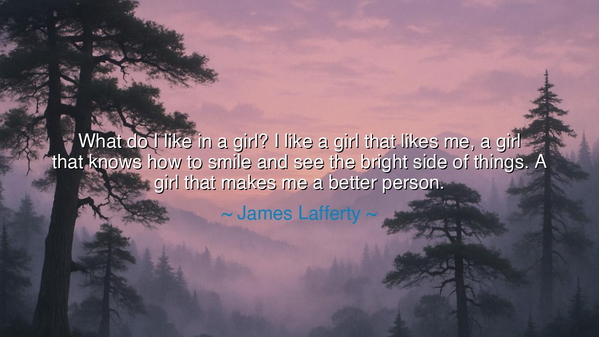
What do I like in a girl? I like a girl that likes me, a girl
What do I like in a girl? I like a girl that likes me, a girl that knows how to smile and see the bright side of things. A girl that makes me a better person.






In the words of James Lafferty, we find a declaration both tender and wise: “What do I like in a girl? I like a girl that likes me, a girl that knows how to smile and see the bright side of things. A girl that makes me a better person.” Though spoken in simplicity, these words carry the weight of timeless truth, for they reveal what men and women have always sought in one another—not merely beauty, nor wealth, nor outward charm, but the deeper power of love that uplifts, heals, and transforms the soul.
To desire a girl that likes me is to long for mutual affection, not one-sided pursuit. In this, Lafferty speaks against vanity and shallow conquest. He does not exalt the chase or the thrill of indifference, but instead honors reciprocity, the meeting of hearts in equal measure. The ancients taught that friendship is the truest ground of love, for in friendship there is equality and respect. In these words lies the understanding that love must be mutual, or else it is but an illusion that fades.
The vision of a girl who knows how to smile and see the bright side of things carries yet greater meaning. The smile is no mere gesture—it is the outward flame of an inward light. To smile in dark times is to wield courage, to see the bright side is to carry hope. Such a person does not deny sorrow, but meets it with resilience, lifting others by her presence. In every age, people have been drawn not to those who magnify despair, but to those who kindle hope in the shadows. A smiling heart is a lantern that guides both itself and others through the valley of trial.
The final phrase is the most profound: “A girl that makes me a better person.” Here, the highest calling of love is revealed. True companionship is not mere pleasure, nor even comfort, but transformation. The one who loves us rightly does not leave us as we are, but draws forth our noblest self. This truth is ancient and enduring. Recall the story of Antony and Cleopatra: though their union was fraught with ruin, it shows how the power of one soul can elevate or destroy another. Lafferty’s longing is for the former—for the kind of love that uplifts, strengthens, and refines the character of the beloved.
We see this wisdom embodied in history as well. Consider Eleanor Roosevelt, who, with her courage and compassion, made Franklin Roosevelt greater than he might have been alone. Her vision of justice, her refusal to hide in the shadows, gave him strength and expanded the moral scope of his leadership. She was one who smiled through hardship, who saw the brighter side of human possibility, and who, by loving, called forth greatness in another. Such examples remind us that the truest loves are not those that flatter, but those that forge.
From these words, the lesson is clear: seek relationships not for fleeting attraction, but for enduring growth. Choose companions who smile not only with lips but with spirit, who see beyond the darkness to the horizon of hope. Surround yourself with those who inspire you, who challenge you to rise above your weakness, and who, by their very presence, make you a better self. And likewise, strive to be such a person for others—to carry light, to see the bright side, and to give love that transforms.
So remember, children of the present age: beauty fades, wealth is fleeting, but the power of mutual love, the courage of the smile, and the gift of becoming better together—these endure beyond time. Let your love be one that lifts, not one that diminishes. And if you find one who makes you better, hold fast, for you have found a treasure greater than crowns or kingdoms. In such love, both souls are ennobled, and the world itself is made brighter.






AAdministratorAdministrator
Welcome, honored guests. Please leave a comment, we will respond soon